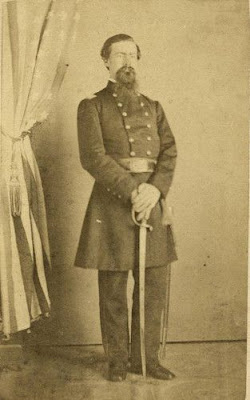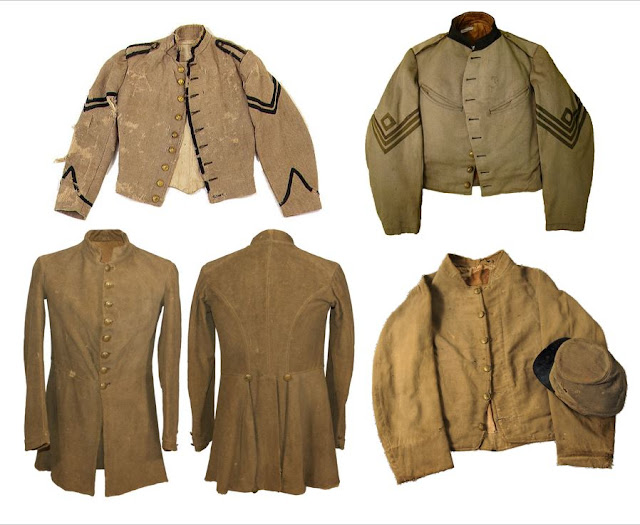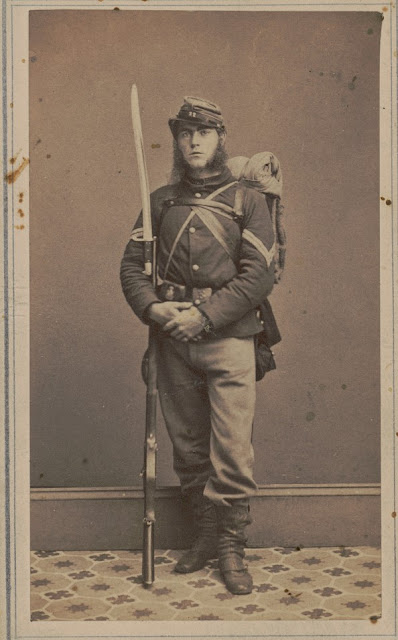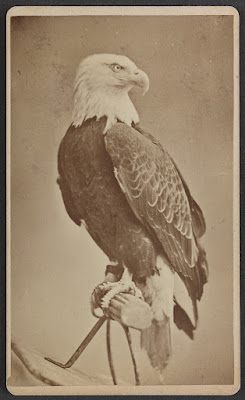Miracle Makers: The 27th Illinois at Stones River
By any measure, the 27th Illinois had already performed a full day's work during their fighting south of the Wilkinson Pike on the morning of December 31, 1862 at Stones River. The regiment had helped repulse multiple Confederate attacks on their position and retreated by General Phil Sheridan's command around 11 a.m.
Moving north along the Nashville Pike in search of ammunition a few hours later, Major William Schmitt now commanding the regiment found himself in the presence of General Rosecrans. The commanding general of the Army of the Cumberland was in a tight spot and needed the 27th Illinois to help hold the line along the Nashville Pike. Schmitt replied that he was nearly out of ammunition but would use the bayonet. Rosecrans agreed and told him to go at the Rebels "quick, quick."
"After retreating over a mile, we struck the road running directly from Nashville to Murfreesboro where we halted and seeing the enemy coming to meet us, we were ordered to form in line of battle and hold the ground at all hazards," remembered Corporal William Lazenby of Co. K. "Major [William] Schmitt now being in command of the regiment reported that we were almost out of ammunition, but when that was gone, we were told to use the bayonet which proved most effectual. Our division still being in front, our brigade was ordered forward but we soon received a most deadly volley from the enemy which took great effect on our ranks, but at the same time, the order was given to charge and one continuous yell was given from our lines. Meeting the Rebels at the double quick, they turned about and we had the pleasure for once of seeing them skedaddle in good earnest. Following them so close under a heavy fire from us, we succeeded in taking a great many of them prisoners besides the killed and wounded."
Corporal Lazenby's description of what I'd like to call the Miracle at the 3-Mile Marker first saw publication in the February 12, 1863, edition of the Jacksonville Journal published in Jacksonville, Illinois.
Camp near Murfreesboro, Tennessee
January 9, 1863
After a
campaign of two weeks of marching and exposure to both wet and cold weather, we
are once more in camp and have got our tents and hope for a short rest. As you
have doubtless heard all the particulars of the late battle, it would be
useless for me to attempt to give you any description of it even if I could. But,
however, I will try to give you a partial account of our proceedings since
leaving Camp Sheridan.
On the 26th
of December, we received orders to march at daylight with five days of rations.
After going about seven miles, we came in contact with the Rebel pickets on the
Nolensville Pike when a sharp skirmish took place, but the Rebels ran and we
marched on. As it was reported that a Rebel force was at Nolensville, we expected
to soon attack them but hearing of our approach, they left without causing us
any trouble. After passing through the village, we encamped nearby but our
regiment was ordered on picket. The weather being cloudy, soon after dark it
commenced raining and rained hard all night. Of course, very little sleep was
enjoyed and having only one blanket each, we were all wet in the morning. After
drying them a short time by the fire, we again began our march and until 3 o’clock
in the afternoon, we occasionally passed a few shots with the enemy who kept a
short distance ahead.
It having
rained most of the afternoon, we were again all wet and used the wet ground for
a bed. However, we were allowed fire and during the night got some sleep. The next
morning being Sunday, we were glad to learn that we were not to move.
The next
morning opened upon us clear and pleasant. We were early under arms and on our
march. Having been traveling directly south, we here turned our course eastward
in the direction of Murfreesboro and traveled within about six miles of that
place over very rough and stony roads and stopped for the night. The next
morning [December 30] we were ordered out and after going about three and a
half miles, we attacked the enemy with our skirmishers and all afternoon
constant firing was kept up by musketry which closed about sundown resulting in
several being wounded but only two or three killed on our side and none in our
regiment.
 |
| Colonel George Williamson Roberts, 42nd Illinois and commanding the brigade at Stones River was killed in action near the Wilkinson Pike on the morning of December 31, 1862. |
We were assigned
to General Sheridan’s division, the third, as was our brigade consisting of
four Illinois regiments, viz. the 22nd, 27th, 42nd,
and 51st, all commanding by Colonel G.W. Roberts of the 42nd.
Our brigade
being in advance, we were ordered on Wednesday morning to open the battle and
at daylight our sharpshooters were sent out and soon heard a continual fire
from musketry and increasing as it lasted. Soon our artillery was put into
position and opened upon the enemy which was soon returned by them. In a short
time, nothing could be distinctly heard but the roar of cannons and the rattle
of musketry, the dead and dying seen laying in all directions around us.
The enemy
worked more down to our right and having previously sent a strong force in that
direction, doubtless with the intention of flanking our army, had them
concealed a short distance from our lines in front of Johnson’s division. At
daylight they charged upon Johnson and although warned to be ready and have his
men in line, he failed to do so and allowed himself to be completely surprised.
Out of his whole command, only one regiment was under arms. The others, with
their equipment off and guns in stack, were carelessly getting breakfast while
their artillerymen were away getting water for their horses when the Rebels
made a dash upon them. The men scattered in all directions and two regiments
did not get their arms out of the stack. The Rebels took 16 pieces of artillery
without even being once fired at. [Corporal Lazenby’s condemnation of Johnson’s
division was a commonly expressed sentiment within the Army of the Cumberland.]
Gaining our
right wing, the enemy was soon in the rear of us and for over two hours we were
exposed to a terrible and destructive fire coming from our front and on both
sides. Our brigade was supporting Captain [Charles] Houghtaling’s battery and
was ordered to hold our ground, but his men were killed and wounded until there
were not enough men left to man the guns and we finally had to leave it but not
until only one horse was left standing, all the others being shot down.
 |
| Captain Charles Houghtaling Battery C, 1st Illinois Light Artillery |
Being ordered
to retreat, we fell back under a heavy fire and having gone a short distance
through a dense forest of young cedars, we were met by General [James] Negley
who informed us that we were surrounded and must fight our way out. But before
this, Colonel Roberts was killed and Colonel [Fazilo] Harrington severely
wounded while supporting the battery.
After
retreating over a mile, we struck the road running directly from Nashville to
Murfreesboro where we halted and seeing the enemy coming to meet us, we were
ordered to form in line of battle and hold the ground at all hazards. Major [William]
Schmitt now being in command of the regiment reported that we were almost out
of ammunition, but when that was gone, we were told to use the bayonet which
proved most effectual.
Our division
still being in front, our brigade was ordered forward but we soon received a
most deadly volley from the enemy which took great effect on our ranks, but at
the same time, the order was given to charge and one continuous yell was given
from our lines. Meeting the Rebels at the double quick, they turned about and
we had the pleasure for once of seeing them skedaddle in good earnest.
Following them so close under a heavy fire from us, we succeeded in taking a
great many of them prisoners besides the killed and wounded. We were now left
in undisputed possession of the ground. [To learn more about this action, check
out “Miracle at the Three-Mile Marker Now a Lake.”]
We lost on Wednesday eight of our company, but none were killed that we know of. E.W. Ticknor, acting captain, was in command of our company throughout the fight and did well as did every man under him. Although Co. K is but small, yet we have as good fighting men in it as the nation affords. But not one desires to kill if it was not necessary, but all feel the love of country and if necessary are willing to lose their lives rather than see the government destroyed and ruled by traitors.
To learn more about Sheridan’s division at Stones River, please check out the following posts:
Surrounded by a Wall of Fire: With Sheridan’s Division at Stones River (22nd Illinois)
We Could Have Driven them to the Gulf: With the 42nd Illinois at Stones River (42nd Illinois)
Shoulder Arms! How Sheridan's and Davis's Divisions Were Armed at Stones River
Source:
Letter from Corporal William Lazenby, Co. K, 27th
Illinois Volunteer Infantry, Jacksonville Journal (Illinois), February
12, 1863
To learn more about the Stones River campaign, be sure to check out my new book "Hell by the Acre: A Narrative History of the Stones River Campaign" available now from Savas Beatie.












Comments
Post a Comment